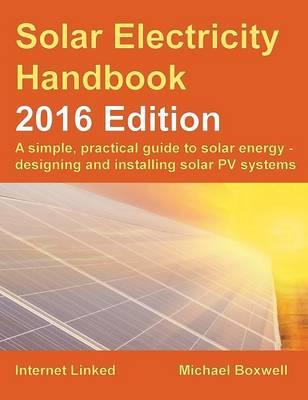Overview
The Solar Electricity Handbook - 2016 Edition, is a simple, practical guide to using electric solar panels and designing and installing photovoltaic PV systems. Now in its tenth edition, the book assumes no previous knowledge of solar electric systems. The book explains how solar panels work and how they can be used. It explains the advantages of solar energy and the drawbacks that you need to take into account when designing a solar power system. As well as explaining the underlying principles, it provides a step-by-step guide so that you can successfully design and install a photovoltaic solar system from scratch. Unlike many guides, The Solar Electricity Handbook explains the principles behind the technology, allowing the reader to design solar energy systems with confidence. The book has been used all around the world, designing systems as diverse as providing entire African villages with electricity, powering vending machines, building grid-tied systems for housing, building a one-off solar electric car and creating lighting for an allotment shed. Accompanying the book is a website that provides solar calculators and online tools to help simplify the solar design process, including a unique database of sunlight values for every major town and city in every country in the world that has been created specifically for this book in conjunction with NASA. Readers can also get in touch with the author directly to ask questions and get further support with their solar projects.
Full Product Details
Author: Michael Boxwell
Publisher: Greenstream Publishing
Imprint: Greenstream Publishing
Edition: New edition
Dimensions:
Width: 19.10cm
, Height: 2.10cm
, Length: 23.50cm
Weight: 0.794kg
ISBN: 9781907670589
ISBN 10: 1907670580
Pages: 248
Publication Date: 11 April 2016
Audience:
General/trade
,
General
Format: Hardback
Publisher's Status: Active
Availability: In Print

This item will be ordered in for you from one of our suppliers. Upon receipt, we will promptly dispatch it out to you. For in store availability, please contact us.
Reviews
Customer Reviews and Quotes: Best solar book I've read, out of four ; I thought I knew what I was doing but I learned a lot ; The greatest Solar Reference book ever published ; Great book for newbies and people who need a refresher! ; Incredible Book of Solar knowledge
Author Information
Michael Boxwell has been designing solar energy systems since the mid 1990s. Initially integrating solar energy into products such as vending machines and portable computers, Michael went on to designing larger systems, including on-building solar and a solar energy systems capable of providing power to entire rural communities in Africa and South America. Michael's most recent solar projects include designing a full-length solar roof for a forthcoming electric car to be launched in 2016 and a solar battery system for residential use. He currently leads a research and development team developing new solar technologies and is based in the United Kingdom.



